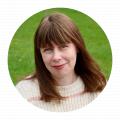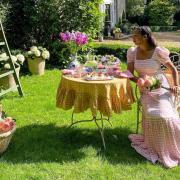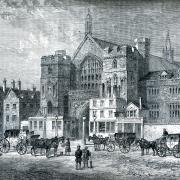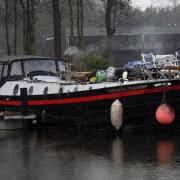Acclaimed for his equine and canine photography, during the Covid lockdowns, Mark Harvey focused his lens on his Norfolk garden, creating a spectacular collection of photos of common birds as you've never seen them before.

In the beginning...
Growing up in Leicestershire, Mark Harvey's creativity was encouraged by his parents. He loved painting and drawing and taking photographs. Aged 12 he moved from an automatic camera to his first SLR camera. And his favourite subjects were 'always fur and feather'. 'I think I've always had an interest in animals,' he says. As a child he would often come to Norfolk at weekends and in the holidays, with lots of time spent around the Snettisham area, which is a wildlife hotspot.
Mark moved to Norwich to study ecology at UEA and, while he enjoyed his studies, he decided to pursue his true passion for photography. In his final year, alongside finishing his degree, he started to build up his photography skills and his own business. He is mostly self-taught and finished his photography studies at Central St Martin's in London.

Finding his style...
Mark was offered some work photographing theatre productions in London. Working with at the theatre where Phantom of the Opera was being staged, and working with the show's crew, he started to realise what an impact lighting can have when creating an image. When Mark started taking head shots for actors, he got his own set of lights and started creating his own style. Not wanting to specialise too soon, to enable him to learn a wide range of skills, he also did family and dog portraiture and was also asked to photograph some horses, which gave him a flash of inspiration.
Horsing around
Mark wanted to explore equine photography further. 'I needed some horses to photograph, so I got the Yellow Pages - this shows how long ago it was - went through it and found livery yards and I jumped into my car and started driving to livery yards with my two A4 photographs,' he says. 'Berries Farm Liveries at Woodbastwick was one of the first and they immediately put me in the diary.'
'What I like about working with animals is that unpredictability and spontaneity, you don't quite know what's going to happen and sometimes the magic happens at the right moment.'
Equine superstar
Word spread through the equine world about Mark's portraits and he has been commissioned by a host of well-known names including Mary King, William Fox-Pitt, Richard Hammond and Andrew Lloyd Webber, to photograph their horses
'Naturally I'm quite good at working around animals. I trained dogs when I was a child,' says Mark. 'Over time you learn how to move around horses - I think the best thing to do is ignore them. You just have to quietly and confidently move things around and make them feel as if they're of no consequence whatsoever.'
His photography won a wider audience when he was asked to photograph Frankel, one of the most famous racehorses in the world.

An idea takes flight
Mark lives in the Broads with his wife and two children. Their garden is teeming with wildlife - including kingfishers, owls and deer. For a number of years he'd been thinking about a project photographing birds in flight. And when the Covid lockdowns meant that he couldn't travel to commissions the idea took off.
'You see birds flying around all the time and when they're flying you don't see any detail, do you? They're just buzzing around. I had this image of it in my mind, of it frozen,' he says. 'And once that snapped into my head I started thinking about how I could get that image and how I would want it to be lit - to give it those sculptural qualities and that vibrancy of colour. It must have been at least eight years ago when I first started thinking about it. I spent quite a bit of time working away trying to get an image that wasn't just a big blurry mess.
'I remember reading a National Geographic article many years ago and were giving advice to photographers and they were saying don't go to far flung countries, go and photograph in your own back garden or you local area because you'll know that area so much more intimately, you'll be able to do a more in-depth job. I'm doing the same with the birds. Taking these birds which are really common birds and not taking them for granted, saying "look how special these birds are". I think they're magnificent and I can show them off to their best.'

You only get one shot
Mark shoots on a Hasselblad camera. 'It's a big, clunky commercial camera. which is designed for shooting billboards, so it produces the most amazing pictures,' he says. 'It's not your typical wildlife camera, but if you get the shot then it's much better than [on] anything else. I make life very difficult for myself. If you go down the route that's easy, everyone has already done that. I don't mind the hard work because I know that it's going to lead to something that's special. When I'm photographing birds it takes quite a lot of time to get the lighting right. I'm a perfectionist, so I will keep on working and working. On shoots, by the end of the day I'm exhausted.'

Going viral
Almost painterly and full of drama, In Flight included portraits of blue tits, magpies and goldfinches.
'The reaction was mindblowing,' says Mark. 'It took me back to when [the portrait of] Frankel was released and the phone was going crazy. A lot of major Instagram accounts were suddenly interested in me - people with three or four million followers were putting out my work on their feed and people were ordering pictures from all around the world. There I was in lockdown and scaling back my work, then suddenly I'm reaching out to a wider audience.'
Pictured here is Mark's recent limited collection of archival pigment prints, The Blue Birds.
'I wanted to keep the same subject, but have a new approach to it, change the aesthetic of them,' says Mark. 'There was a lot of experimenting with different colours.'
Breaking the rules
'I feel like I started off as a photographer and now I'm evolving into an artist,' says Mark. 'I love wildlife photography, but I don't feel like I'm beholden to the rules of a traditional wildlife photographer. You can do anything you want to, you can reinterpret these images how you want to. Every project, I break free a bit more from the rules and get a bit more creative. I'm experimenting with using different methods of printing and using motion imagery to create lenticulars so when you walk past them you get movement.'
To see more of Mark's work visit mark-harvey.com




























